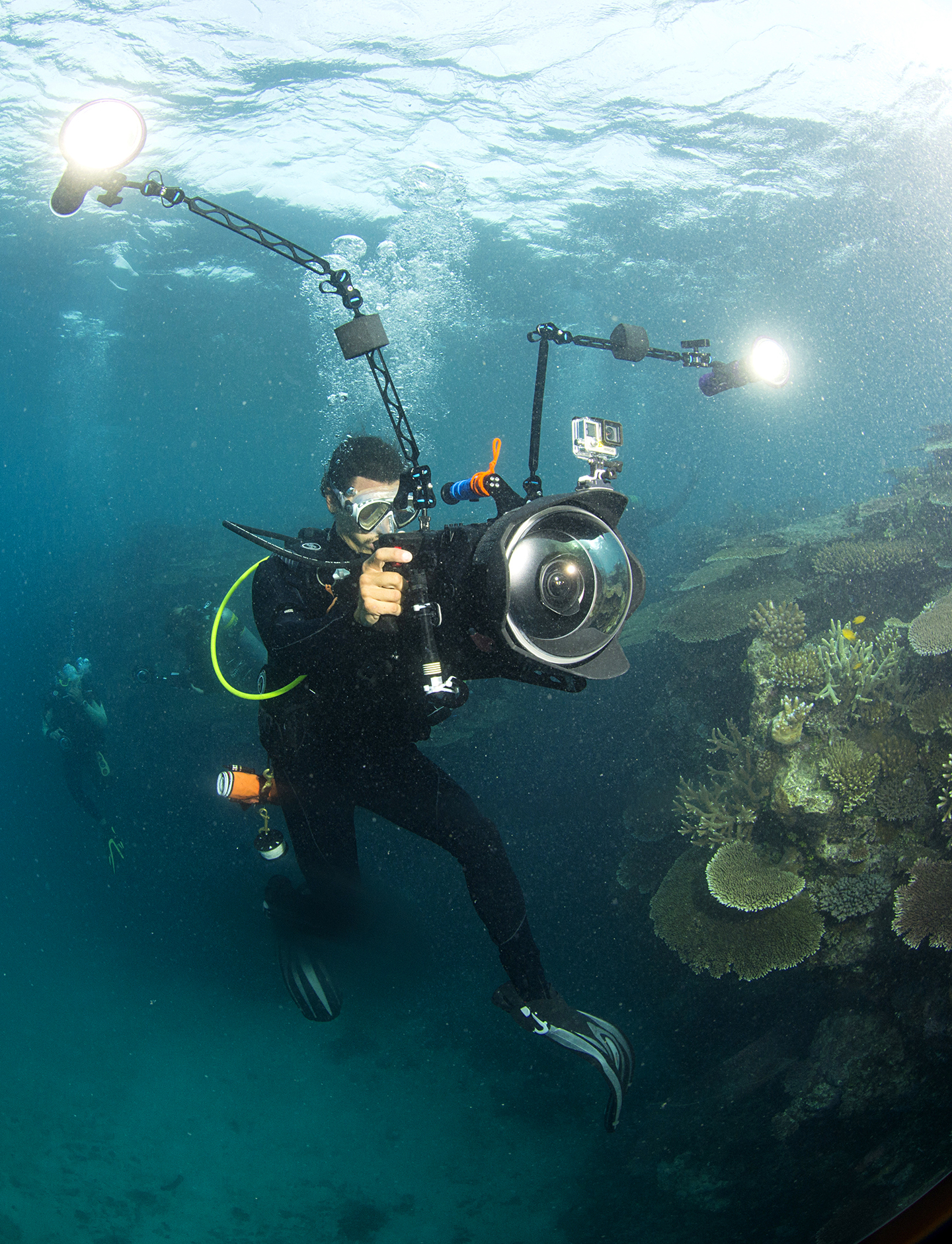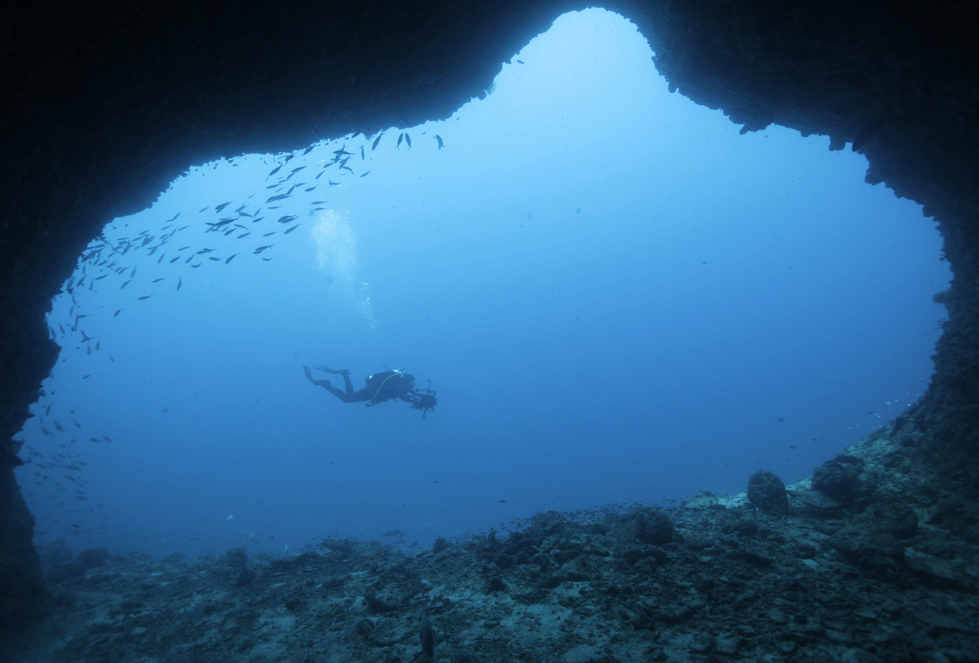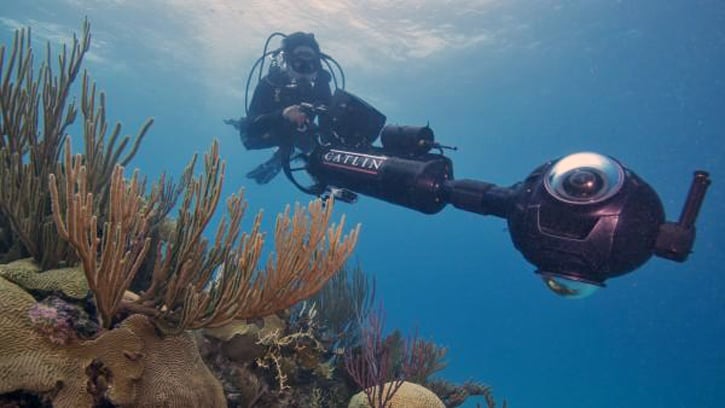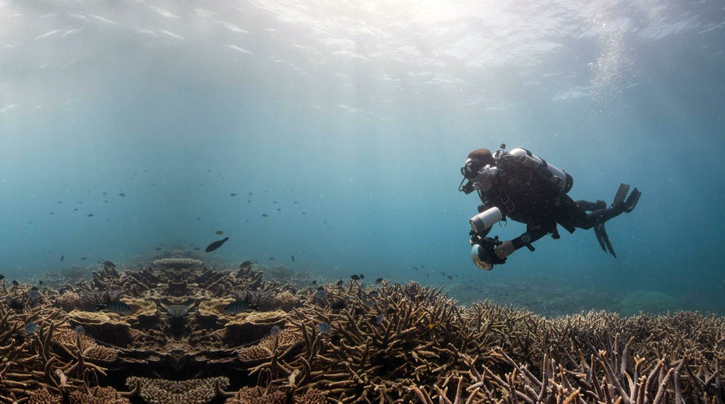
Underwater Production for Chasing Coral
Shooting the award-winning documentary in "affordable" 4K using a multitude of camera systems.
Shooting the award-winning documentary in “affordable” 4K using a multitude of camera systems.
This year, the Sundance Film Festival introduced a thematic thread: The New Climate. Fourteen projects on the environment — a longtime passion of event founder Robert Redford — got a shout-out under that banner, beginning on opening night with Al Gore’s An Inconvenient Sequel.
The film that spoke most directly to climate was Chasing Coral. Winner of the Documentary Audience Award, it follows photographers, divers, and scientists as they document the quick and dramatic death of coral reefs when ocean temperatures rise.
At the center of this three-and-a-half year endeavor was director/producer Jeff Orlowski, who shared cinematography credits with diver master Andrew Ackerman. (Contributions were also made by nine underwater cameramen, 33 on additional camera, and six more for manual time-lapse, plus divers from 25 countries for local reports in the global call.) Like Orlowski’s Emmy-winning film on melting glaciers, Chasing Ice (AC Oct., 2012), the narrative thread is the documentary process itself: assembling a team, getting input from scientists, and adapting camera systems to photograph these underwater organisms in all their living glory and sobering death.

The story begins with Richard Vevers, a London advertising executive who left that world to start the XL Catlin Seaview Survey, pioneering the underwater use of Google street-view cameras. During those dives, he noticed disturbing changes: disappearing sea creatures, lifeless coral reefs bleached bone-white. As Vevers recounts in the film, he happened to see Chasing Ice on an airplane and immediately sought out its director. Streaming street-views of the reefs was no longer enough, he realized. Context was needed.
Orlowski quickly came on-board. Initially the idea was to somehow continue with the street-view camera. “Then the bleaching story became more and more of a real thing,” the Boulder-based cinematographer recalls. During their first shoot together in Bermuda, Vevers was floored by the massive scale of bleaching there and started peppering Orlowski with questions about time-lapse, so effectively used in Chasing Ice. Was it possible underwater?

The answer was yes, but with formidable challenges. As Orlowski explains in the film, “We have a camera submerged in salt water for months on end that is subject to huge storms and hurricanes, at depth, with all the tremendous pressure of millions of gallons of water pressing down. That is very, very difficult to do.” Fortunately he and Vevers are both optimists by nature. “I think that’s why Richard and I resonate so much. It’s like, yeah, we can get to the moon, so we can solve this,” Orlowski says.
But first, they faced a conceptual hurdle: Coral death isn’t a tagline that brings in the crowds. “How do we get them in the door?” the director asks. “How do we get them to fall in love with these places, then be affected by it emotionally?”
One answer was to show the coral reefs in all their splendor. Another was to make viewers connect with the divers. That meant changing the modus operandi for underwater photography, which typically relies on super-wide fisheyes and macro lenses. Instead, Orlowski wanted a medium zoom and depth of field. “We’re trying to tell a story of a team underwater,” the director says. “It’s not just vague, anonymous bodies swimming through a beautiful landscape. We were trying to do close-ups of people’s faces. How do you see someone’s emotions underwater? We needed the zoom option.” What’s more, he continues, “You can’t easily change a lens. You put the camera in the housing, go underwater, and for 50 minutes or an hour, you’re stuck with that one lens option.” As Ackermann adds, “The housing is vacuum-sealed, so even changing a lens on the boat is a difficult swap.” A zoom eased those restraints.

To operate a zoom inside its underwater housing, they got a prototype lens ring from housing specialist Nauticam. “It’s an engineering marvel,” says Orlowski of the system, which comprises rings that grip and spin the zoom and focus rings, then attach to buttons and dials on the outside of the housing through a complex system of gears. “If the teeth line up a teeny bit wrong, it doesn’t work,” says Ackerman. “You’ve got a little 5" monitor,” says Orlowski, “and you’re trying to do rack focus with people and fish underwater. It’s a very fun challenge.”
The majority of underwater actuality footage—of the dive teams and vividly colored reef ecosystems—was captured on Red systems. “We knew even in 2013 that we wanted to future-proof this film, to do it in 4K,” says Orlowski. Raising funds, they bought an Epic and took that out with a Canon EOS-1D C on their first footage test. “It was very clear that the 1D C doesn’t hold up the same way that the Red did, so we switched over to having two Reds,” says Orlowski. As the years clicked by, they brought in a Red Dragon. “The idea was that Andrew and I could shoot underwater at the same time—one wide, one tight—to cut verité-style underwater.” Working with a Canon EF 24–70mm and 16–35mm, “Andrew would stay in the 16-35 range, and I’d be in the 50–70mm range.” They occasionally used a Canon EF 100mm macro, Canon 8–15mm, and Canon 11–24mm.
Additional cameras included GoPros, the Sony XDCAM PXW-FS7 for out-of-water shooting, plus the Panasonic Lumix DMC-GH4 for time-lapse. “The goal was 4K, but affordable 4K,” says Orlowski.

Then there was the matter of learning how to move the camera underwater. Orlowski had done only five dives previously. Ackerman was a master diver, but deemed himself “a very amateur underwater photographer and aspiring documentary filmmaker” before Chasing Coral. Vertical camera position is a question of buoyancy—that is, how much breath is held in your lungs. “If you exhale too much, you’d descend very fast and crush and kill a bunch of coral,” Orlowski observes. But both relished the freedom of underwater shooting. “You’re now a jib and a Steadicam and a dolly all in one. It’s really, really fun,” Orlowski says. Ackerman adds, “There are times you’re upside-down filming. I’d look over at Jeff and his fins are straight up and the camera is straight down, and he’s got to hold that position perfectly still in the water to get a clear shot.”
But it was the time-lapse that posed the biggest technical challenge. Orlowski went to Boulder-based View Into the Blue, known for underwater webcams, to get dome-shaped housing that could accommodate a GH4, along with a CleanSweep magnetic wiper that would keep the housing clean of biomass for months at a time.
To program their time-lapse, the GH4s had to be hacked. “Trevor Mendelow is an engineering genius,” says Orlowski of View Into the Blue’s CEO. “We told him what we needed from a technical perspective, like how to deal with exposures, with focus, having an intervalometer. Trevor custom-programmed all the software to do that.”
The hard physical work came next: securing time-lapse stations to the ocean bottom in Bermuda, the Bahamas, and Hawaii, where scientists predicted imminent coral bleaching. That was essentially underwater construction with no leverage. Then for camera set-up, they utilized Mendelow’s system, diagramed in the film: “Person in boat wirelessly connects to a computer in a case, which is hard-wired to an umbilical cable that goes down onto a router inside an underwater housing, that then communicates wirelessly to the camera.” As Orlowski elaborates, “The boat needed to be nearby to plug it in. We were on the boat with an iPad and could see the settings underwater and change them, which was a brilliant technical solution. Unfortunately, the lens that we used, for some reason, drifted out of focus,” despite being set on manual.
Discovering that a month’s worth of images were useless set off a demoralizing crisis for the team, captured in the documentary. Orlowski had never heard of manual focus drift, and the tests had gone well. Fortunately, one of their five time-lapse cameras had a different, wider lens and held focus just fine. “That’s when we knew if we changed the lenses, it would work,” says Orlowski. So they switched out their motorized Panasonic Lumix 12–42mm for a fixed Lumix 8mm fisheye.
The reason behind the lens drift remains a mystery. “I think powering may have been the issue, causing a problem between the lens itself and the camera body,” speculates engineer Mendelow, who wasn’t able to replicate it afterwards. “Being a motorized lens, set to a particular zoom setting in manual mode, introduces the possibility of many electrical anomalies.”
Upon switching lenses, they went to autofocus. “That allowed us to eliminate the whole tether in the boat. It was a trade-off that made the installation much, much easier,” says Orlowski. “We also left shooting 4K video. When we switched to autofocus, we switched to a still-photo burst mode. So instead of shooting 30 seconds of video like we did in the first iteration, we now did a bunch of photos in rapid succession. If a fish came and went and the focus shifted, we could just ditch those images. We had so many.”
But after all that, Mother Nature changed plans. The bigtime coral bleaching was happening elsewhere: in the Great Barrier Reef off northeast Australia. Suddenly there was a time crunch. Realizing there wasn’t enough time or personnel to move the fixed time-lapse stations, Orlowski made a tough call: They’d do it manually.
The work was tedious and exhausting. For a month, Orlowski and “coral nerd” Zack Rego went to 60 spots a day, while Ackerman, working solo in a different location, covered 50. “We set out a schedule based on consistent lighting and what will look best,” says Orlowski. They used both the Red Dragon and GH4, shooting 4K or 6K, depending on the system. “We rolled for about two minutes for each ‘instance’ and then sped up each clip and blended them together to make the time lapses,” he says.
To replicate camera position, “it was constantly trial and error,” says Orlowski. Ackerman tapped PVC pipes into the sand where he’d insert the tripod legs, whereas Orlowski set down metal plates with coasters to mark leg position. “We didn’t have a ball-head on the tripods,” notes the director. “That was a big regret. I had to adjust alignment by adjusting all three tripod legs.” Framing was fine-tuned using laminated photographs and underwater lasers zip-tied to the camera body. Galvanized nails fixed into dead rock served as reference points. “It’s just triangulating something in 3D space, like high school physics all over again,” says Orlowski. Sometimes coral shapes acted as reference points, but these would break as the coral died.
Being present to watch the ancient reefs die took an emotional toll. “It was a hard experience watching beautiful coral—the most beautiful thing I’d ever seen—die a bit every day,” says Ackerman. “Ninety percent of this film was the biggest dream come true. To get to work with one of the best documentary directors out there was just unbelievable. But ten percent was really the saddest and most depressed I’ve ever been.”
All told, they shot around 144 terabytes of footage for the film. “On location, we’d have 4TB Seagates and just load a couple of backpack sleeves with those,” Ackerman says. “Back in the office, we had a total of six ThunderBay 4s from Other World Computing,” each coupled with four 8TB Seagate internal drives. The film was cut on Adobe Premiere and color corrected at Final Frame in New York City.
Immediately after its Sundance premiere, Orlowski signed a deal with Netflix, contingent on their support of an outreach campaign that expands upon the Chasing Ice model. The earlier film went wide and deep, screening in 172 countries, the White House, and United Nations, as well as saturating the Ohio congressional district of Rep. Pat Tibury, a climate-change denier. (The resulting community pressure led the congressman to change position.) “We want to do that same concept, except even bigger with this film,” says Orlowski. “We’re trying to move the needle.”





